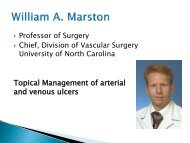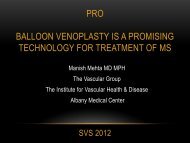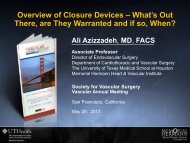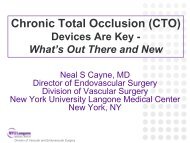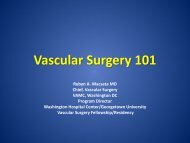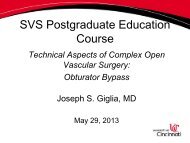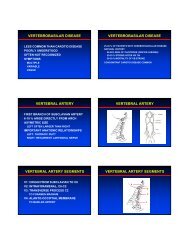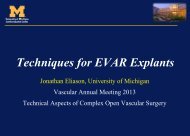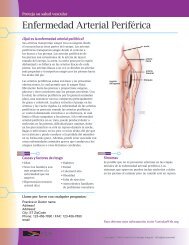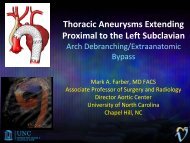Varicose Veins - VascularWeb
Varicose Veins - VascularWeb
Varicose Veins - VascularWeb
You also want an ePaper? Increase the reach of your titles
YUMPU automatically turns print PDFs into web optimized ePapers that Google loves.
Protect Your Vascular Health<br />
<strong>Varicose</strong> <strong>Veins</strong><br />
What is a varicose vein<br />
Swollen, blue, bulging, twisted, superficial (those closest<br />
to the skin) veins of the leg are known as varicose veins.<br />
What causes varicose veins<br />
High pressure inside the superficial veins of the leg cause<br />
varicose veins. Genetics are thought to play a large role in<br />
contributing to varicose veins.<br />
What are the effects of varicose veins<br />
Left untreated, varicose veins may become worse. Persons<br />
with varicose veins often experience leg aches and fatigue.<br />
Skin changes may include rashes, redness, and sores.<br />
Are diagnostic tests available for<br />
varicose veins<br />
Yes. After obtaining a medical history and completing<br />
a physical exam, physicians examine prominent veins.<br />
Then, physicians may apply a tourniquet or direct hand<br />
pressure to observe how the veins fill with blood.<br />
To identify the causes of varicose veins, physicians may<br />
order a duplex ultrasound test. The painless test uses<br />
high-frequency waves to measure the speed of blood<br />
flow. The test helps visualize the vein structure and the<br />
blood flow in the veins. The test can take approximately<br />
10-20 minutes per leg.<br />
How common are varicose veins<br />
As many as 40 million Americans have varicose veins.<br />
What factors influence development of varicose veins<br />
Age is a factor. People between the ages of 30 and 70 often have<br />
varicose veins.<br />
During pregnancy, 50 to 55 percent of American women<br />
experience varicose veins. In most cases, the veins return to<br />
normal within a year after childbirth. Women who have multiple<br />
pregnancies may develop permanent varicose veins.<br />
The varicose vein risk factors for women and men include:<br />
• a family history of varicose veins,<br />
• being overweight,<br />
• standing or sitting for long periods of time,<br />
• having a deep vein thrombosis (DVT).<br />
Please call with any questions:<br />
For more information visit <strong>VascularWeb</strong>.org<br />
®<br />
Copyright © 2012, Society for Vascular Surgery®. All rights reserved
Protect Your Vascular Health<br />
What are the initial treatment options for<br />
varicose veins<br />
Most doctors will suggest lifestyle changes for patients with varicose<br />
veins. This includes:<br />
• maintaining the proper weight,<br />
• elevating legs when resting,<br />
• not sitting or standing for long periods of time,<br />
• wearing compression (elastic support) stockings.<br />
This is the mainstay of treatment.<br />
Vascular surgeons are the only physicians<br />
treating vascular disease today who can<br />
perform all treatment options available<br />
including: medical management; minimally<br />
invasive endovascular procedures including<br />
balloon angioplasty, and stent ablation of<br />
the veins procedures; and open surgical<br />
repair including bypass and stripping.<br />
Additional treatments for varicose veins<br />
Sclerotherapy is the sealing of the veins via an injection of a<br />
medication. This procedure is done mainly for smaller spider<br />
veins. It is performed in a doctor’s office. The physician injects<br />
a chemical into the varicose veins to prevent the veins from<br />
filling with blood.<br />
Vein Stripping is performed for more involved varicose veins.<br />
The physician may make two small incisions: one in the groin<br />
area and another below the knee. Next, the physician removes<br />
the diseased veins.<br />
In a similar procedure known as Transilluminated Powered<br />
Phlebectomy or TIPP, the physician shines an intense light on<br />
the leg to see the veins. Once the physician locates the varicose<br />
vein, he or she passes a suction device through a tiny incision<br />
and suctions out the vein. The procedure is relatively painless.<br />
Ablation and laser treatment are performed on patients with<br />
severe varicose veins. The ablation procedure inserts a catheter,<br />
a thin, flexible tube into the leg vein. The tip of the catheter<br />
has tiny electrodes that heat and seal off the walls of the vein.<br />
Similarly, laser treatments use a tiny fiber placed in the vein<br />
through a catheter. The fiber sends out laser energy that closes<br />
the diseased portion of the vein.<br />
Only when you see a vascular surgeon<br />
who offers all treatment modalities will<br />
you be assured of receiving the care that<br />
is most appropriate to your condition.<br />
These two modes of treatment frequently replace stripping of<br />
the saphenous vein as described above. These procedures can<br />
be performed alone or in conjunction with removal of individual<br />
clusters of varicose veins known as small incision avulsion or<br />
ambulatory phlebectomy.<br />
Please call with any questions:<br />
For more information visit <strong>VascularWeb</strong>.org<br />
®



